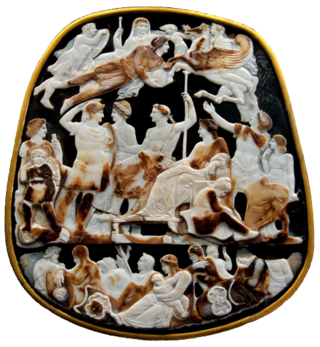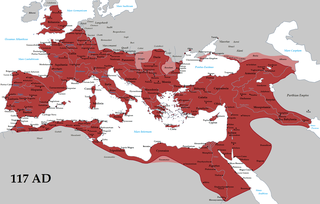
The Julio-Claudian dynasty comprised the first five Roman emperors: Augustus, Tiberius, Caligula, Claudius, and Nero.

The 10s decade ran from January 1, AD 10, to December 31, AD 19.

The 30s decade ran from January 1, AD 30, to December 31, AD 39.

The 70s was a decade that ran from January 1, AD 70, to December 31, AD 79.
AD 36 (XXXVI) was a leap year starting on Sunday of the Julian calendar. At the time, it was known as the Year of the Consulship of Allenius and Plautius. The denomination AD 36 for this year has been used since the early medieval period, when the Anno Domini calendar era became the prevalent method in Europe for naming years.
AD 38 (XXXVIII) was a common year starting on Wednesday of the Julian calendar. At the time, it was known as the Year of the Consulship of Iulianus and Asprenas. The denomination AD 38 for this year has been used since the early medieval period, when the Anno Domini calendar era became the prevalent method in Europe for naming years.
AD 40 (XL) was a leap year starting on Friday of the Julian calendar. At the time, it was known as the Year of the Consulship of Augustus without colleague. The denomination AD 40 for this year has been used since the Early Middle Ages, when the Anno Domini calendar era became the prevalent method in Europe for naming years.
Herod I or Herod the Great was a Roman Jewish client king of the Herodian kingdom of Judea. He is known for his colossal building projects throughout Judea. Among these works are the rebuilding of the Second Temple in Jerusalem and the expansion of its base—the Western Wall being part of it. Vital details of his life are recorded in the works of the 1st century CE Roman–Jewish historian Josephus.

Herod Agrippa, also known as Agrippa I or Agrippa the Great, was the last king of Judea. He was a grandson of Herod the Great and the father of Herod Agrippa II, the last known king from the Herodian dynasty. He was an acquaintance or friend of Roman emperors and played crucial roles in internal Roman politics.

Herod Agrippa II, officially named Marcus Julius Agrippa and sometimes shortened to Agrippa, was the last ruler from the Herodian dynasty, reigning over territories outside of Judea as a Roman client. Agrippa II fled Jerusalem in 66, fearing the Jewish uprising, and he supported the Roman side in the First Jewish–Roman War.

Herod Antipas was a 1st-century ruler of Galilee and Perea. He bore the title of tetrarch and is referred to as both "Herod the Tetrarch" and "King Herod" in the New Testament. He was a son of Herod the Great and a grandson of Antipater the Idumaean. He is widely known today for accounts in the New Testament of his role in events that led to the executions of John the Baptist and Jesus of Nazareth. His father, Herod the Great, was described in the account as ordering the Massacre of the Innocents, marking the earliest Biblical account of the concerns of the government in Jerusalem regarding Jesus' existence.

The Jewish–Roman wars were a series of large-scale revolts by the Jews of Judaea against the Roman Empire between 66 and 135 CE. The term primarily applies to the First Jewish–Roman War (66–73) and the Bar Kokhba revolt (132–136) which sought restoring Judean independence that was lost since the Hasmonean civil war. Some sources also include the Diaspora Revolt (115–117), a campaign waged by the Jewish diaspora across the Eastern Mediterranean.

Judaea was a Roman province from 6 to 132 CE, which at its height incorporated the Levantine regions of Judea, Idumea, Samaria, and Galilee, and parts of the costal plain including Philistia, extending over the territories of the Hasmonean and Herodian kingdoms. The name Judaea was derived from the Iron Age Kingdom of Judah, that was centered predominantly in Judea.

The Herodian dynasty was a royal dynasty of Idumaean (Edomite) descent, ruling the Herodian Kingdom of Judea and later the Herodian tetrarchy as a vassal state of the Roman Empire. The Herodian dynasty began with Herod the Great who assumed the throne of Judea, with Roman support, bringing down the century-old Hasmonean Kingdom. His kingdom lasted until his death in 4 BCE, when it was divided among his sons and daughter as a tetrarchy, which lasted for about 10 years. Most of those tetrarchies, including Judea proper, were incorporated into Judaea Province from 6 CE, though limited Herodian de facto kingship continued until Agrippa I's death in 44 CE and nominal title of kingship continued until c. 92 or 100 CE, when the last Herodian monarch, king Agrippa II, died and Rome assumed full power over his de jure domain.

The Herodian tetrarchy was a regional division of a client state of Rome, formed following the death of Herod the Great in 4 BCE. The latter's client kingdom was divided between his sister Salome I and his sons Herod Archelaus, Herod Antipas, and Philip. Upon the deposition of Herod Archelaus in 6 CE, his territories were transformed into a Roman province. With the death of Salome I in 10 CE, her domain was also incorporated into a province.
Herodian coinage were coins minted and issued by the Herodian Dynasty, Jews of Idumean descent who ruled the province of Judaea between 37 BC – 92 AD. The dynasty was founded by Herod the Great who was the son of Antipater, a powerful official under the Hasmonean King Hyrcanus II.

The Herodian kingdom was a client state of the Roman Republic ruled from 37 to 4 BCE by Herod the Great, who was appointed "King of the Jews" by the Roman Senate. When Herod died, the kingdom was divided among his sons into the Herodian Tetrarchy.
Publius Petronius was a Roman senator, who was active during the reigns of Caligula and Claudius. He was suffect consul in the second half of the year 19, replacing Lucius Norbanus Balbus. The sortition also awarded him the proconsulate of Asia; however, Petronius is best known as having appointed legatus or governor of Syria in 39, probably arriving in the country late in the year. A.A. Barrett lists him as an example of the "excellent appointments" made by an emperor often dismissed as mentally unbalanced.

Cypros (1st-century) was a queen consort of Judea. She was married to king Herod Agrippa.

This article lists historical events that occurred between 1–100 in modern-day Lebanon or regarding its people.













